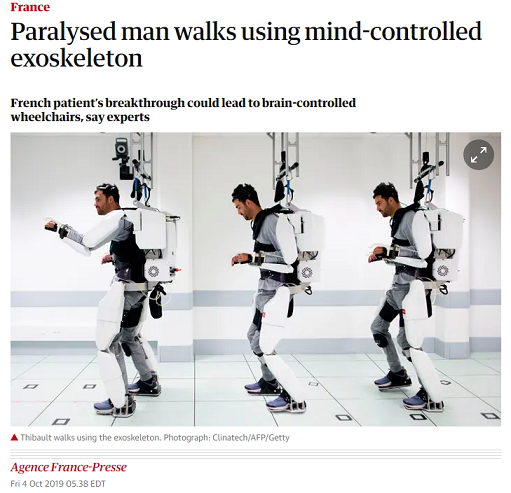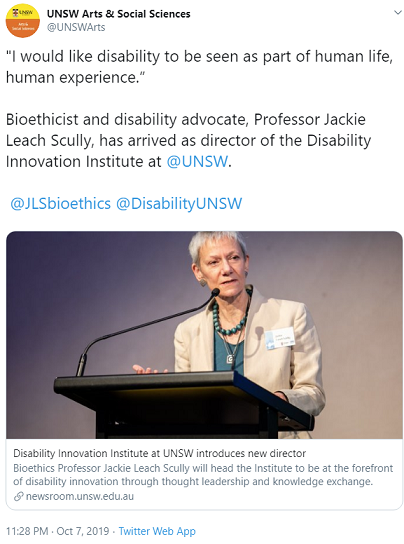EDITOR’S NOTE: Sometimes contributors to IJFAB Blog find themselves having an informal conversation in person or on social media about a news event. When these conversations might shed light on otherwise-overlooked issues, a blog entry featuring some of the ideas can share them with IJFAB Blog readers. This is one such blog entry.
On Friday October 4, a week ago, a flurry of news articles heralded a new technologically-sophisticated mobility device. The device? A “brain-controlled exoskeleton” that could “provide[e] hope to tetraplegics[/quadriplegics] seeking to regain movement.” The successful use of the device was achieved after months of training the user to harness their brain signals in order to control a computer-simulated avatar. The user, a 28 year old French man named Thibault from Lyon, said “When you are in my position, when you can’t do anything with your body… I wanted to do something with my brain… I can’t go home tomorrow in my exoskeleton but I’ve got to a point where I can walk. I walk when I want and I stop when I want.”

While many bioethics accounts on Twitter and social media gushed with the possibilities, or simply relayed the news story without comment, some feminist bioethicists were more skeptical. Regular IJFAB Blog contributors Jackie Leach Scully, Joe Stramondo, and Alison Reiheld had a brief conversation about their concerns.
Where others were involved in the conversation and did not wish to be named in this blog but are critically important to the flow of conversation, their comments are summarized.

Jackie Leach Scully 
Joe Stramondo 
Alison Reiheld
ALISON: Unlikely to be affordable (or covered by insurance), I fear. Many people with mobility disabilities lack the kinds of resources necessary to acquire this kind of resource, for complex reasons that include disability stigma in hiring and in medicine. But pretty neat.
PERSON 1 suggests that many medical devices start off as for the rich only but eventually get cheap enough for regular folks and insurance; unfair, but better than not having it at all, perhaps
ALISON: well, the real problem is if a society sinks resources into developing these tech solutions which function at the individual level but which most individuals can’t access, in lieu of supporting systemic solutions (like supports for disabled folks, like making buildings and interactions less disabling, etc ).
JACKIE: I think there’s also an issue about the tension (sometimes conflict) between a mindset that prioritizes devices that try to enable a person with a disability to function/look like the norm, vs one that looks around at the environment and asks, what can we do to make this work better for people with disabilities? I’m not saying that it has to be one rather than the other. But I’m interested in the way that so much media and public attention is paid to the exoskeleton versus (to take one example that’s appeared at about the same time) the newly built library in Queens that has areas that are completely inaccessible to wheelchair users. I get it that exoskeletons are exciting and hightech and sexy, and ramps and accessible bathrooms are, well, not very. But it does say something about the way that non-normative form and function is assumed somehow always to be second-best.
PERSON 1 suggests that it may be correct that just making a place wheelchair accessible is probably cheaper than an exoskeleton, even if an exoskeleton is, in some situations perhaps better than a wheelchair.
ALISON: well… Cheaper for whom? I think that is part of the issue here: who will have to do the labor, bear the cost, etc. As well as how big the cost is. It is important to know that patients are often on the hook for their own assistive devices. I was just talking the other day with a person who saved for two years and did two kick starters to put together the $20k she needed to get a power chair that would let her leave the house without a personal assistant. That is the funding environment into which this device arrives.
JACKIE: Also, at best accessibility benefits everyone, not just PWD. Ramps benefit everyone shifting things in wheels: parents with prams or strollers, people with shoppers, anyone with a wheeled suitcase…and don’t actively disadvantage anyone. Not sure how exoskeleton benefits anyone except the user, and company that sells it. I know I may be coming across as hypercritical, but the knee jerk recourse to individualized, high tech, commercial products to solve the ‘problem’ of disability is so universal, and so infrequently challenged, it’s dispiriting.
JOE: I think it’s a mistake to assume that, under our current scheme anyway, devices like this will ever be covered by health insurance. There are very narrow definitions of “medical necessity” that are relied upon and that exclude much technology that would improve opportunities for disabled folks. See for example the case of the iBot wheelchair: https://mobilitymgmt.com/…/Independence-Technology…
In particular see this paragraph: “For instance, iBOT’s signature abilities — and presumably, ones that contribute heavily to that $26K price tag — are climbing stairs and rising up to balance on two wheels. But Medicare typically does not pay for seat-elevating systems, and does not consider stair-climbing to be a medically necessary function.”
I suspect this tech ends up being researched as assistive technology but utilized and profited off of in the defense industry. That’s just speculation of course.
PERSON 2 argues that narrow definitions of medical necessity are better than broader ones
JOE: I absolutely agree with you. The solution isn’t to widen definitions of medical necessity but to justify provision of this tech in completely non-medical terms. I have an article coming out soon titled “The Right to Assistive Technology” that makes exactly this argument.
ALISON: I think it would be good to have something from a disability bioethics perspective out there. Yesterday, [major bioethics journal] tweeted about it with much excitement. The goal is to give a sampler of stances quickly for folks who would otherwise react with technophilia.
JOE: Oooooo….!
JACKIE: I’m happy with that.
ALISON: It’s worth adding that this kind of innovation will only benefit certain people in certain economies in certain countries. Emphasis on high tech solutions are virtually guaranteed to be solutions for only the very few. Good low tech solutions for the many are necessary.
JOE: I would also add that, while I’m skeptical of the viability of the exoskeleton as AT [assistive technology], the neurotech used here may end up being hugely important to disabled folk. A BCI [brain computer interface] controlled wheelchair or prosthetic would be revolutionary. Also, in addition…. BCI-equipped communication devices would be very cool.
For more on these kinds of ideas from these and other thinkers see, in no particular order:
- Joseph A. Stramondo. 2018. “The distinction between curative and assistive technology.” Science & Engineering Ethics 25(4): 1125-1145. (open access journal article)
- Alison Reiheld. 2018. “A Gimlet Eye: The Journal of Controversial Ideas and Jonathon Anomaly’s “Defending Eugenics”.” Discrimination and Disadvantage. (scholarly blog)
- Joseph Stramondo. 2016. “Dwarfism, Chemical Limb Lengthening, and Informed Consent.” IJFAB Blog. (scholarly blog)
- Jackie Leach Scully and Teresa Blankemeyer Burke. 2019. “Russia’s CRISPR ‘Deaf Babies’: The Next Genome Editing Frontier?” Impact Ethics. (scholarly blog)
- Jackie Leach Scully. 2008. Disability Bioethics: Moral Bodies, Moral Difference. (book)
- Dialogues on Disability: Shelley Tremain Interviews Alison Reiheld
- Dialogues on Disability: Shelley Tremain Interviews Joe Stramondo
- Jackie Leach Scully. 2018. “I keep telling you… I can’t get in the building.” IJFAB Blog. (scholarly blog)
- Jackie Leach Scully. 2019. “The responsibilities of the engaged bioethicist: Scholar, advocate, activist.” Bioethics 33(8): 872-880. (open access journal article)



Excellent discussion. More!
yes, assistive technology is great. Thankyou